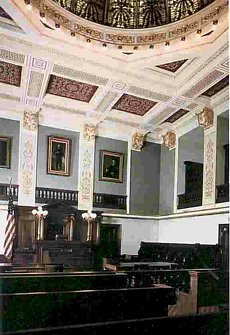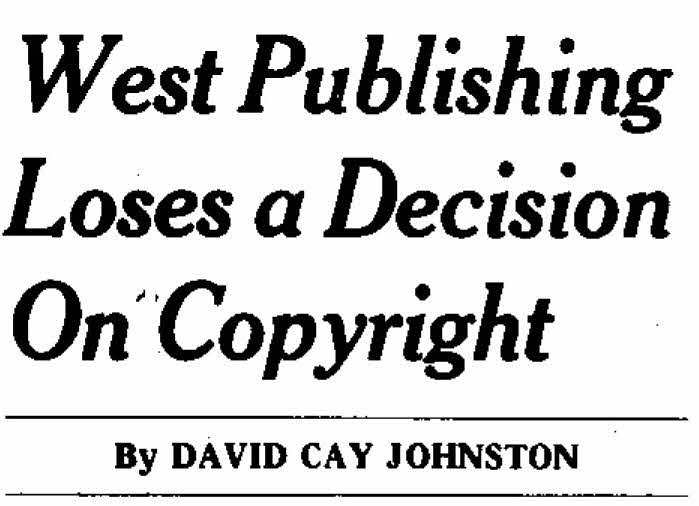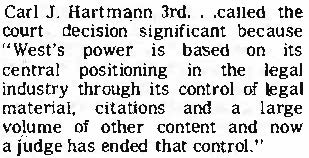UNITED STATES DISTRICT COURT
FOR THE SOUTHERN DISTRICT OF NEW YORK
MATTHEW BENDER & COMPANY, INC., Plaintiff,
-v.-
WEST PUBLISHING COMPANY, Defendant.
________________________________________
HYPERLAW, INC., Intervenor-Plaintiff,
-v.-
WEST PUBLISHING COMPANY, Defendant.
94 Civ. 0589
1997 U.S. Dist. LEXIS 6915; 42 U.S.P.Q.2D (BNA) 1930;
Copy. L. Rep. (CCH) P27,638; 25 Media L. Rep. 1856
May 19, 1997, Decided
May 19, 1997, FILED
COUNSEL:
For plaintiffs: Paul Ruskin, Douglaston, N.Y.; Carl J. Hartmann III, New York, NY
For defendants: James Rittinger, Satterlee Stephens Burke & Burke, New York, N.Y.
MEMORANDUM OPINION AND ORDER
JOHN S. MARTIN Jr., District Judge:
This action raises the question of the extent of the copyright protection available to West Publishing Company with respect to the opinions of the United States Supreme Court and the Circuit Courts of Appeals that it publishes in the Supreme Court Reporter and the Federal Reporter Series.
There is no question that West invests substantial time in reviewing each opinion, checking the citations, adding parallel citations, modifying the caption to conform to its style and adding information concerning the attorneys involved and subsequent history of the case. n1 [1] The issue presented here is whether the changes West makes to an opinion, either singly or in combination, represent a sufficient creative effort to warrant copyright Protection.[*2]
BACKGROUND
In this case the plaintiff, Hyperlaw, Inc., is the publisher of CD-ROM products, one of which contains recent Supreme Court cases, and the other, recent Circuit Court of Appeals cases. Although Hyperlaw obtains the text of most of the current cases from sources other than West, in a small percentage of cases it scans the title, texts and certain other information directly from the West reports. It does not, however, scan the headnotes that West adds to its reports or the key numbers it inserts in the opinions.
In addition, Hyperlaw intends to expand its products so that a user reviewing an opinion can see the full text of any case cited in the opinion by simply clicking on the citation. Since many of the cited cases are from before 1990 when Hyperlaw began collecting the cases, it intends to scan these cases into its product directly from the West Reporters. Alan Sugarman, Hyperlaw's President, admitted that this process of obtaining cited cases might ultimately result in Hyperlaw scanning up to 75% of West cases into its system. n2 [2]
DISCUSSION
The determination of the legal issues presented involve the balancing of competing policy considerations. Since as children we all had drilled into our heads the maxim: "Thou shall not copy," it seems fundamentally unfair to allow Hyperlaw to take advantage of the substantial time and expense West has invested in its reporters by engaging in wide-ranging copying of the opinions published by West. On the other hand, the opinions published by West are written, not by West, but by federal judges and it seems unfair to say that West can preclude anyone from copying what is basically a government document.
Since the extent of copyright protection varies depending on the nature of the copyrighted work, i.e. greater protection exists for original works than is available for compilations or derivative works, the first issue the Court must address is the nature of the copyright protection at issue. Feist Publications, Inc., v. Rural Telephone Serv. Comp., Inc., 499 U.S. 340, 348-49, 111 S. Ct. 1282, 1289, 113 L. Ed. 2d 358 (1991).
West contends that it has a copyright in the compilation of the reporters and, therefore, the legality of plaintiff's conduct must be [*4] judged by the standards that apply to compilations. Hyperlaw argues that it is not copying the order of cases used by West or its indices, but only individual opinions, and that the extent of West's protectible interest in any single opinion must be determined under the standards that apply to derivative works.
The Court agrees that the correct analysis is that which applies to derivative works. The fact that Hyperlaw scans hundreds of cases rather than a single case does not mean that it is copying "those aspects of the compilation that embody the original creation of the compiler." CCC Info. Serv., Inc. v. Maclean Hunter Mkt. Reports, Inc., 44 F.3d 61, 66 (2d Cir. 1994). West's compilation copyright protects its arrangement of cases, its indices, its headnotes and its selection of cases for publication, but these are not what Hyperlaw is copying. What Hyperlaw is copying is the individual reported decision and the fact that it copies one, two or a thousand decisions does not change the fact that it is the decisions and not West's compilation of those decisions that Hyperlaw is copying.
Section 101 of the Copyright Act defines a derivative work as a "work consisting of editorial [*5] revisions, annotations, elaborations, or other modifications which, as a whole, represent an original work of authorship . . . ." 17 U.S.C. § 101. Thus, in its most simple form, the question presented is whether each reported decision found in the West reports is an original work of West authorship.
The Second Circuit recently reviewed the standards to be applied to determine whether a derivative work is entitled to copyright protection in Woods v. Bourne Co., 60 F.3d 978, 990 (2d Cir. 1995) stating:
In order for a work to qualify as a derivative work it must be independently copyrightable. . . .(citations omitted). The basis for copyright protection contained in both the constitution and the Copyright Act is originality of authorship. . . . (citations omitted).
We thoroughly discussed the standard of originality in a derivative work in our in banc decision in Batlin. There we held that "there must be at least some substantial variation [from the underlying work], not merely a trivial variation." (quoting L. Batlin & Son, Inc. v Snyder, 536 F.2d 486, 491 (2d Cir.) (in banc), cert. denied, 429 U.S. 857, 97 S. Ct. 156, 50 L. Ed. 2d 135 (1976)).
The changes [*6] that West makes to an opinion that it publishes do not make the reported decision "independently copyrightable." If one looks at each opinion as a whole then it seems clear that the changes made by West are trivial indeed. Minor changes to the caption, the identification of judges and information as to the attorneys, together with the insertion of subsequent history, are not sufficient to qualify West's reprints as "original works of authorship." 17 U.S.C. § 102(a).
What West endeavors to do here is to ignore the work as a whole and look at each individual change and argue that it changes substantially that particular piece of information. For example, West argues that it makes a substantial change to the cases cited in an opinion when it adds a parallel citation. Even if this were a substantial change to that citation, it is still a trivial change to the court's opinion.
In order to determine whether the opinions, as reported in West, are entitled to copyright protection, it is necessary to look at the significance of each individual change only for the purpose of determining whether the totality of the changes made by West can be said to constitute "an original work of authorship." [*7]
The first change that West makes to a court opinion is in the title of the case. West will capitalize those names or portions thereof that will be used in citing the case, sometimes abbreviate portions of the parties' names, sometimes combine captions when two or more cases are reported together and make other minor changes to ensure that a consistent form is used in all reported decisions. It is hard to characterize the changes made in the title as involving creative activity. Rather, they are simply a mechanical application of preexisting rules of citation. While West rules may vary somewhat from A Uniform System of Citation, which is generally used throughout the legal community, the differences do not appear to be of major significance. The case names are facts reported by the courts and West's modifications thereto are not significant enough to give it a protectible interest in the case title. As Judge Leisure observed in his thorough and well-reasoned opinion in Hearn v. Meyer, 664 F. Supp. 832, 847 (S.D.N.Y. 1987):
It is well understood that authors wishing to express ideas within the context of factual background often can choose from only a limited number [*8] of terms. Copyright protection is afforded rarely where a fact permits only a narrow continuum or spectrum of expression.
West lists with the case title, the docket number and the date argued and decided. These are clearly facts and even though West must make some effort to obtain some of this information, there is nothing so original about West's expression of these facts that would entitle them to copyright protection. Feist, 499 U.S. at 350-51, 111 S. Ct. at 1290. As the Supreme Court noted in Feist, "raw facts may be copied at will. This result is neither unfair nor unfortunate. It is the means by which copyright advances the progress of science and art." Id. at 350; 111 S. Ct. at 1290.
West adds to the title a "file line" that will give subsequent history, such as "rehearing denied" and the date of the action. In most instances these are straightforward factual summaries of court action and the choice of methods of expressing these developments is generally limited and subject to widely accepted rules of citation.
A more substantial question is presented by the decisions that West makes with respect to subsequent opinions issued by the court in the same case [*9] that either correct or modify the earlier opinion. In such instances West must make a judgment whether to combine the two opinions, publish them separately or simply make the correction in the final bound volume. Here again the options are limited and the decision does not involve any creative effort which would transform West's report of the decision into an original work by West.
West next claims a protectible interest in its publication of the names of the attorneys. While in many cases it takes some effort for West to gather the names and to identify the city where the defendant practices, these are facts which West cannot copyright. Feist, 499 U.S. at 360, 111 S. Ct. at 1295; Financial Information v. Moody's Investors Serv., 808 F.2d 204, 208 (2d Cir. 1986) (copyrightability is "not determined by the amount of effort the author expends, but rather by the nature of the final result."). While West clearly makes an editorial judgment as to which attorneys' names to publish and whether to add the city of practice, there are only a limited number of choices to be made. Certainly West could not prevent a competitor who was not copying West's opinions from using the identical [*10] method for reporting the names of the attorneys involved in the case. Hearn v. Meyer, 664 F. Supp. at 847. While Hyperlaw's blatant copying of this material may offend one's sense of basic fairness, it does not mean that West has an interest in the attorneys' names that the copyright laws were designed to protect.
West may make some changes in the presentation of the names of the judges involved in the decision but these changes are clearly trivial.
West makes two types of changes within the text of the opinions: corrections and additions. West cite checkers carefully review each decision and correct any misspellings or errors in either the form or the substance of the citations. In some instances the court will be called to determine whether there is an error in the opinion. While West clearly expends considerable time and money on this effort and performs a valuable service to the bench and the bar, there is no element of creativity or originality involved in these corrections.
There are two types of additions that West makes to the opinions. One involves the filling in of blanks, such as a reference back to a portion of the same opinion or a blank left in a citation because [*11] the official reporter in which the cited case appears had not been printed at the time the original decision was filed. This mechanical search for and addition of facts is clearly not protected by copyright. Feist, 499 U.S. at 362, 111 S. Ct. at 1296.
The most significant additions that West makes to the opinions that it reports are its inclusion of parallel citations and its changes to citations to cite to a more readily available source. In most instances the determination of which parallel citations to include are basically mechanical and reflect no level of originality. Here again the selections made tend to conform to the standard of the legal profession and appear consistent with those recommended in A Uniform System of Citation. Surely the decision to cite to a bound volume rather than an advance sheet or a computerized source does not reflect even a modicum of originality. Nor do the limited number of instances in which West makes a judgment as to which of a number of equally accessible sources should be cited give to its case reports a sufficient level of originality to invoke the protection of the Copyright Act.
In sum, each of the changes that West makes to the [*12] cases it reports are trivial and, taken separately or collectively, they do not result in "a distinguishable variation" of the opinion written by the court. Waldman Publishing Corp. v. Landoll, Inc., 43 F.3d 775, 782 (1994).
Since the Court has determined that West does not have a protectible interest in any of the portions of the opinions that Hyperlaw copies or intends to copy, there is no need to reach the question of whether West's copyright notice complies with the requirements of Section 403 of the Copyright Act or whether Hyperlaw would be entitled to a defense of fair use. Indeed, since this Court cannot predict which elements of the case reports published by West the Second Circuit might find entitled to protection, a fair use analysis cannot be done.
The Court would note, however, that there does appear to be an interplay between section 403 and the fair use analysis. As the Court noted at an earlier stage in this litigation, in deciding the question of fair use, "analysis begins not by elevating the statutory guides to inflexible rules, but with a review of the underlying equities." Weissmann v. Freeman, 868 F.2d 1313, 1323 (2d Cir. 1989). Section 403 clearly reflects [*13] a judgment by Congress that those who publish material that basically comes from government sources should not be able to appropriate that material for themselves simply by incorporating additional material into the text without giving adequate notice to the public of that portion of the document that contains material protected by the publishers' copyright. Thus, in doing a fair use analysis with respect to any reprint of an opinion published by West, it would be reasonable to weigh against West the fact that it does nothing to indicate to the public which portions of the reprinted opinions contain new matter added by West as to which they claim a copyright.
CONCLUSION
Since West has no copyright interest in those elements of the reported opinions which Hyperlaw is copying and intends to copy, Hyperlaw is entitled to a judgment that its copying on the opinions from the West reports does not violate West's copyrights.
The foregoing shall constitute the Court's findings of fact and conclusions of law.
SO ORDERED.
Dated: New York, New York
May 19, 1997
JOHN S. MARTIN, JR., U.S.D.J.
[1] n1 West also prepares headnotes which digest the issues decided. There is no claim in this case that West is not entitled to copyright protection with respect to headnotes.
[2] n2 West raises issues with respect to justiciability, which in the end rest on its objection to Mr. Sugarman's testimony at trial. The decision to permit this testimony was argued at trial and will not be revisited here.


.jpg)
